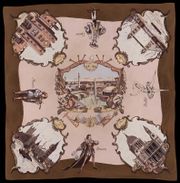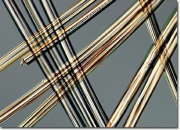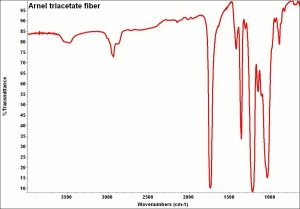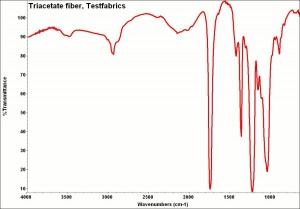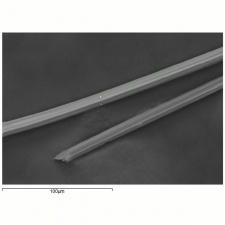Difference between revisions of "Triacetate fiber"
m (Text replace - "== Authority ==" to "== Sources Checked for Data in Record ==") |
|||
| (6 intermediate revisions by 2 users not shown) | |||
| Line 1: | Line 1: | ||
| + | [[File:Triacetate scarf MFA.jpg|thumb|Triacetate scarf<br>MFA# 2001.2388]] | ||
| + | == Description == | ||
[[File:triacetatefiberslarge.jpg|thumb|Triacetate fiber]] | [[File:triacetatefiberslarge.jpg|thumb|Triacetate fiber]] | ||
| − | + | A manufactured fiber produced from [[cellulose%20triacetate|cellulose triacetate]]. Cellulose triacetate was first developed by Schutzenberger in 1865. However, this early acetate was a tough hard [[plastic|plastic]] that contained high amounts of [[acid|acids]] and was only soluble in expensive chlorinated [[solvent|solvents]]. Thus, cellulose triacetate was not commercially viable until the mid-1950s when economical solvents became available. Triacetate is a durable fiber that is resistant to wrinkles, stains, chemicals, sunlight, insects, and moisture. It should not be dry-cleaned but is not degraded by normal laundering. It dries quickly in air or cool driers and maintains its shape without ironing. Triacetate is a crisp, firm fabric that is often used in [[taffeta|taffetas]] and [[suiting|suitings]]. It is used in drip-dry clothing, tablecloths, skirts, and slacks. It is often used in wool blends to increase washability and crease retention. A surface saponification finishing process, called S-Finishing, is often applied to triacetate fabrics to minimize static. | |
| − | + | See also [[acetate%20fiber|acetate fiber]]. | |
| − | |||
| − | See also [ | ||
== Synonyms and Related Terms == | == Synonyms and Related Terms == | ||
| Line 11: | Line 11: | ||
[[[SliderGallery rightalign|Arnelfiberkj1.jpg~FTIR|TriacetateTestfabrics.jpg~FTIR|arnel500m.jpg~SEM]]] | [[[SliderGallery rightalign|Arnelfiberkj1.jpg~FTIR|TriacetateTestfabrics.jpg~FTIR|arnel500m.jpg~SEM]]] | ||
| − | + | == Risks == | |
| − | == | ||
| − | |||
| − | |||
| − | |||
| − | |||
| − | |||
| − | |||
| − | |||
| − | |||
| − | |||
| − | |||
| − | |||
| − | |||
| − | |||
| − | |||
| − | |||
| − | |||
Subject to static cling | Subject to static cling | ||
| + | == Physical and Chemical Properties == | ||
| − | + | *Soluble in chloroform, methylene chloride, m-cresol, 90% phenol | |
| − | + | *Insoluble in acetone | |
| − | + | *Unaffected by dilute acids, alkalis and bleaches | |
| + | *Cross section is bulbous; fiber has longitudinal striations | ||
| + | *Tenacity = 1.1-1.4 g/denier (dry); 0.7-0.8 g/denier (wet) | ||
| + | *Elongation 25-35% (dry); 30-40% (wet) | ||
| + | *Moisture regain = 2.5-3.5% | ||
| + | *CAS# = 9012-09-3 | ||
| + | *Melting Point = 300 | ||
| + | *Density = 1.32 | ||
== Comparisons == | == Comparisons == | ||
| Line 40: | Line 31: | ||
[[media:download_file_44.pdf|Properties of Synthetic Fibers]] | [[media:download_file_44.pdf|Properties of Synthetic Fibers]] | ||
| − | + | == Resources and Citations == | |
| − | |||
| − | == | ||
* Hoechst Celanese Corporation, ''Dictionary of Fiber & Textile Technology'' (older version called Man-made Fiber and Textile Dictionary, 1965), Hoechst Celanese Corporation, Charlotte NC, 1990 | * Hoechst Celanese Corporation, ''Dictionary of Fiber & Textile Technology'' (older version called Man-made Fiber and Textile Dictionary, 1965), Hoechst Celanese Corporation, Charlotte NC, 1990 | ||
| Line 52: | Line 41: | ||
* ''Identification of Textile Materials'', The Textile Institute, Manchester, England, 1985 | * ''Identification of Textile Materials'', The Textile Institute, Manchester, England, 1985 | ||
| − | * J.Gordon Cook, ''Handbook of Textile Fibres:II Man-made Fibres'', Merrow Publishing Co. , Durham, England | + | * J.Gordon Cook, ''Handbook of Textile Fibres:II Man-made Fibres'', Merrow Publishing Co. , Durham, England, 1984, p.99. |
| − | * Wikipedia | + | * Wikipedia: http://en.wikipedia.org/wiki/Triacetate (Accessed Nov. 9, 2005) |
* ''Van Nostrand's Scientific Encyclopedia'', Douglas M. Considine (ed.), Van Nostrand Reinhold, New York, 1976 | * ''Van Nostrand's Scientific Encyclopedia'', Douglas M. Considine (ed.), Van Nostrand Reinhold, New York, 1976 | ||
Latest revision as of 13:26, 5 December 2020
Description
A manufactured fiber produced from Cellulose triacetate. Cellulose triacetate was first developed by Schutzenberger in 1865. However, this early acetate was a tough hard Plastic that contained high amounts of acids and was only soluble in expensive chlorinated solvents. Thus, cellulose triacetate was not commercially viable until the mid-1950s when economical solvents became available. Triacetate is a durable fiber that is resistant to wrinkles, stains, chemicals, sunlight, insects, and moisture. It should not be dry-cleaned but is not degraded by normal laundering. It dries quickly in air or cool driers and maintains its shape without ironing. Triacetate is a crisp, firm fabric that is often used in taffetas and suitings. It is used in drip-dry clothing, tablecloths, skirts, and slacks. It is often used in wool blends to increase washability and crease retention. A surface saponification finishing process, called S-Finishing, is often applied to triacetate fabrics to minimize static.
See also Acetate fiber.
Synonyms and Related Terms
triacetate fibre; Arnel® [Celanese, America]; Tricel [British Celanese]; Trilan; primary acetate; JPS [Courtaulds]; Courpleta [Courtaulds];fibra de triacetato(Esp.)
Risks
Subject to static cling
Physical and Chemical Properties
- Soluble in chloroform, methylene chloride, m-cresol, 90% phenol
- Insoluble in acetone
- Unaffected by dilute acids, alkalis and bleaches
- Cross section is bulbous; fiber has longitudinal striations
- Tenacity = 1.1-1.4 g/denier (dry); 0.7-0.8 g/denier (wet)
- Elongation 25-35% (dry); 30-40% (wet)
- Moisture regain = 2.5-3.5%
- CAS# = 9012-09-3
- Melting Point = 300
- Density = 1.32
Comparisons
Properties of Synthetic Fibers
Resources and Citations
- Hoechst Celanese Corporation, Dictionary of Fiber & Textile Technology (older version called Man-made Fiber and Textile Dictionary, 1965), Hoechst Celanese Corporation, Charlotte NC, 1990
- Rosalie Rosso King, Textile Identification, Conservation, and Preservation, Noyes Publications, Park Ridge, NJ, 1985
- Marjory L. Joseph, Introductory Textile Science, Holt, Rinehart and Winston, Fort Worth, TX, 1986
- Identification of Textile Materials, The Textile Institute, Manchester, England, 1985
- J.Gordon Cook, Handbook of Textile Fibres:II Man-made Fibres, Merrow Publishing Co. , Durham, England, 1984, p.99.
- Wikipedia: http://en.wikipedia.org/wiki/Triacetate (Accessed Nov. 9, 2005)
- Van Nostrand's Scientific Encyclopedia, Douglas M. Considine (ed.), Van Nostrand Reinhold, New York, 1976
